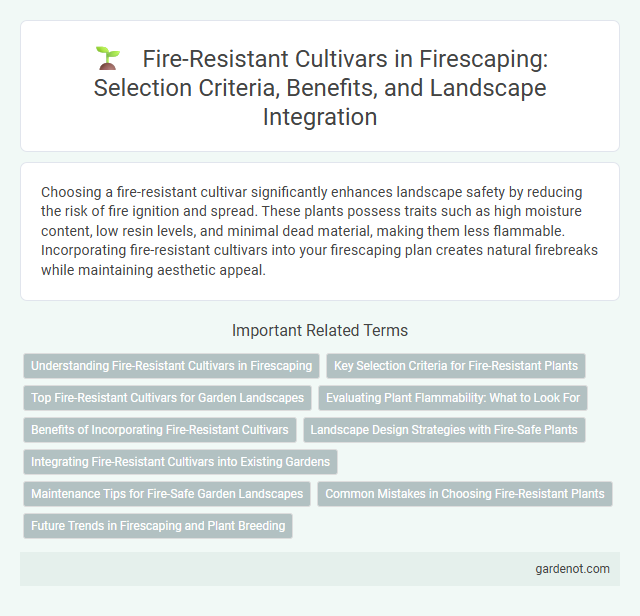Choosing a fire-resistant cultivar significantly enhances landscape safety by reducing the risk of fire ignition and spread. These plants possess traits such as high moisture content, low resin levels, and minimal dead material, making them less flammable. Incorporating fire-resistant cultivars into your firescaping plan creates natural firebreaks while maintaining aesthetic appeal.
Understanding Fire-Resistant Cultivars in Firescaping
Fire-resistant cultivars play a crucial role in firescaping by reducing the risk of wildfire damage through traits such as high moisture content, low resin, and slow growth rate. These plants are often native species like manzanita, ceanothus, and aloe, which are naturally adapted to survive fire-prone environments. Proper selection and placement of fire-resistant cultivars create defensible space and help protect structures from wildfire exposure.
Key Selection Criteria for Fire-Resistant Plants
Fire-resistant cultivars are chosen based on low resin and oil content, high moisture levels in leaves, and minimal accumulation of dead plant material, which reduce flammability. Selection prioritizes slow-growing, dense foliage with fire-retardant properties and deep root systems to retain moisture during dry conditions. Plants with these characteristics help create effective defensible spaces in firescaping efforts.
Top Fire-Resistant Cultivars for Garden Landscapes
Top fire-resistant cultivars for garden landscapes include species such as California lilac (Ceanothus spp.), manzanita (Arctostaphylos spp.), and succulents like Agave and Aloe, known for their high moisture content and reduced flammability. These plants not only enhance garden aesthetics but also play a crucial role in mitigating wildfire risks by slowing fire spread and maintaining defensible space around properties. Selecting fire-resistant cultivars strategically supports sustainable firescaping practices, promoting safety and resilience in fire-prone areas.
Evaluating Plant Flammability: What to Look For
Evaluating plant flammability requires examining key traits such as moisture content, resin levels, and volatile oils, which significantly influence a cultivar's fire resistance. Fire-resistant cultivars typically exhibit high moisture content and low concentrations of flammable compounds, reducing ignition risk. Selecting species with thick, succulent leaves and minimal dead material further enhances the landscape's resilience to wildfires.
Benefits of Incorporating Fire-Resistant Cultivars
Incorporating fire-resistant cultivars significantly reduces the risk of wildfire damage by limiting combustible plant material near structures, enhancing property protection. These cultivars often require less maintenance and irrigation, contributing to sustainable landscaping practices in fire-prone regions. Utilizing fire-resistant plants also supports biodiversity by promoting native species adapted to local fire regimes.
Landscape Design Strategies with Fire-Safe Plants
In fire-resistant landscape design, selecting fire-safe plants such as drought-tolerant succulents, deciduous trees with high moisture content, and low-resin shrubs significantly reduces fuel load. Strategic placement of fire-resistant cultivars around structures creates defensible space and slows fire spread, enhancing property protection. Integrating these plants with proper irrigation and regular maintenance ensures a resilient, aesthetically pleasing fire-safe landscape.
Integrating Fire-Resistant Cultivars into Existing Gardens
Integrating fire-resistant cultivars into existing gardens enhances landscape resilience by reducing flammable vegetation and creating natural firebreaks. Selecting species such as succulents, lavender, or certain native shrubs with low resin and oil content minimizes fire spread while maintaining aesthetic appeal. Incorporating these plants strategically around structures and pathways improves overall garden safety without compromising biodiversity.
Maintenance Tips for Fire-Safe Garden Landscapes
Fire-resistant cultivars such as manzanita, ceanothus, and lavender thrive in fire-safe garden landscapes by reducing combustible materials. Pruning these plants regularly to remove dead branches and maintaining adequate spacing minimizes fuel continuity and limits fire spread. Consistent watering and mulching with non-flammable materials further enhance their fire resistance and overall landscape safety.
Common Mistakes in Choosing Fire-Resistant Plants
Choosing fire-resistant plants often involves misconceptions such as assuming all succulents are safe or that native species always reduce fire risk. Many gardeners overlook the importance of plant moisture content, resin levels, and maintenance practices, which significantly impact flammability. Proper selection requires understanding specific fire-resistant cultivars like California lilac or manzanita that combine low combustibility with landscape adaptability.
Future Trends in Firescaping and Plant Breeding
Fire-resistant cultivars are rapidly evolving due to advancements in plant breeding techniques that enhance traits such as low resin content, high moisture retention, and compact growth forms. Genetic research and CRISPR technology are being applied to develop species that withstand high temperatures and reduce wildfire fuel loads. Future firescaping trends emphasize integrating these scientifically engineered cultivars into landscape designs to create resilient, sustainable environments that mitigate fire risks.
Fire-resistant cultivar Infographic

 gardenot.com
gardenot.com